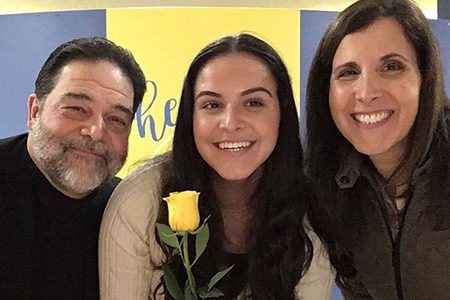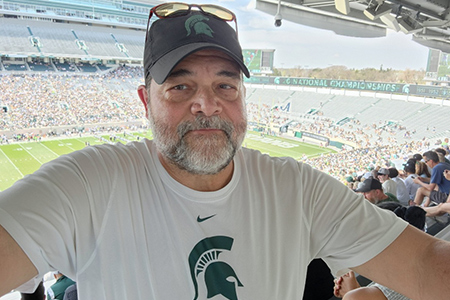Finding the Right Team
One night in September 2022, Rick Kaczmarek was taking a shower when it felt like something in his chest had exploded.
 “I thought I was having a heart attack,” says Rick, 65, a semi-retired Troy resident who works part-time as a tennis coordinator. “I had excruciating pain that was radiating to my back.”
“I thought I was having a heart attack,” says Rick, 65, a semi-retired Troy resident who works part-time as a tennis coordinator. “I had excruciating pain that was radiating to my back.”
The day had started off normal enough.
“We had just bought a new house,” Rick says. “We got a dumpster and started throwing stuff out at our old house. When we got done for the day, I took my shower, and that’s when it happened.”
Rick didn’t even take the time to dry off. He put pajamas over his wet body and his wife rushed him to a local hospital. The ER team evaluated him, took two EKGs and gave him something for the pain.
“They didn’t tell me what was going on, but said it wasn’t a heart attack,” Rick says. “I was worried. I couldn’t feel my leg, it was completely numb.”
Although he didn’t know it at the time, it would turn out to be an aortic dissection. The aorta is the largest artery in the body, and it runs from the heart down to the abdomen, supplying blood to the body. Aortic dissection occurs when there is a tear in the inner layer of the aorta, leading to the separation of its layers, which can cause potentially fatal internal bleeding.
“They told me they would need to medivac me by helicopter to another hospital, but the helicopter couldn’t fly,” Rick says.
Ultimately, they rushed Rick by ambulance to Henry Ford Hospital in Detroit.
A complex medical history
 Rick has a family history of cardiovascular issues, including his parents, brother and uncle, but these didn’t happen until middle age or later in life. For Rick, it started as a teenager.
Rick has a family history of cardiovascular issues, including his parents, brother and uncle, but these didn’t happen until middle age or later in life. For Rick, it started as a teenager.
“I was diagnosed with high blood pressure at 17,” Rick says. “But it eventually went back down on its own.”
When he was 24, he got another sign. At the time, he was working as a grad assistant at Michigan State University, where he also coached football.
“I ran all the way up the stadium stairs, and I felt like they were swaying,” Rick says. “They sent me to the trainer and my blood pressure was 170 / 110. I’ve been on medication since then.”
Living an active lifestyle with regular exercise is one of the key prescriptions for controlling high blood pressure, and throughout his life Rick has been active, especially as a runner. He ran the 10-mile Crim race and finished the Detroit Marathon in 3 hours and 29 minutes, or roughly 8-minute miles. A lifelong fan of tennis, he began playing in his late 40s.
During this period of his life, Rick didn’t experience any cardiovascular issues, but did have two acid reflux attacks, both of which were bad enough to land him in a local ER. During the second one, they did an angiogram to examine blood flow through his coronary arteries.
“I didn’t have any heart blockages,” Rick says. “The doctor thought something had broken off and was working its way through.”
Rick started seeing a cardiologist at that point but didn’t have any issues until September 2022 when he was rushed to Henry Ford Hospital.
A life-threatening aortic dissection
When Rick and his wife arrived at the hospital, they met with Kyle Miletic, M.D., heart surgeon and aortic specialist at Henry Ford Health.
“I was pretty drugged up at that point, so I only remember pieces,” Rick says. “But it was here that we learned a CT scan at the other hospital showed I had a dissection on my ascending aorta, and that it was life-threatening.”
The ascending portion is the beginning of the aorta, which is located near the heart, and includes the aortic arch. The ascending portion receives blood directly from the heart before sending it through the descending aorta and out to the rest of the body. A tear on the ascending portion is known as a type A aortic dissection. This condition is often associated with sudden, severe chest or back pain.
Dr. Miletic told them they would need to do an open heart procedure immediately to replace the torn part of Rick’s aorta.
“I remember going into the OR,” Rick says. “I felt like I was going into an orchestra hall, there were so many people there. A lot of hustle and bustle, but it was all very controlled.”
Rick had just one request before they put him out.
“I wanted to say a prayer,” he says. “So, they got prepped, stopped everything and we did a prayer.”
When Rick woke up in recovery, his wife, daughter and sister were there, and Dr. Miletic came in shortly after, reintroducing himself. “He told me, ‘I’m the guy who ran you over with a truck,’” Rick says. “It was a lot of pain, but the staff handled it well.”
Recovery … and a second procedure
Rick was in the hospital for 10 days before he was discharged.
“Once I got home, I started walking again,” Rick says. “Within a month, I was walking 2.5 miles, twice a day.”
A month after his procedure, Rick returned for a routine follow-up visit, where a CT scan showed an aortic aneurysm of his descending thoracic aorta (the section past the aortic arch that runs through the chest).
When the wall of the aorta weakens, it can form an aneurysm, or bulge. While this condition is not immediately life threatening, it can increase the risk for developing a dissection. In Rick’s case, his original dissection weakened the walls of his descending aorta, which caused the new aneurysm. It was rapidly growing and needed to be repaired.
“I was impressed by Dr. Miletic,” Rick says. “He explained the difference between the dissection and aneurysm and what we needed to do for my second procedure, and he was very personable.”
Two months later, Dr. Miletic performed a complex, minimally invasive procedure known as a thoracic endovascular aneurysm repair (TEVAR) with septostomy, which is used to treat bulges and tears in the upper aorta. During the procedure, a catheter (thin, flexible tube) is inserted into an artery in the groin, then guided to the aneurysm. Once there, the surgeon places a stent graft, a fabric-covered, metal-mesh tube. This reinforces the aorta and helps prevent the aneurysm from growing or rupturing.
Getting back up to speed
 “After my procedure, I needed to take it easy and avoid certain exercises like lifting heavy items, since this can increase the pressure in my thoracic region,” Rick says.
“After my procedure, I needed to take it easy and avoid certain exercises like lifting heavy items, since this can increase the pressure in my thoracic region,” Rick says.
He was also a little hesitant in other areas, including taking a shower and traveling.
“I felt a little PTSD when taking a shower, since that’s where it happened the first time. I would make sure the water wasn’t too hot, and I would get in and get out quickly. It’s only been in about the last month that I’ve felt comfortable taking a normal shower again. And I was afraid for a while to leave this area and be far from my Henry Ford team. But we eventually went up to Mackinac Island and biked around the island two or three times each day.”
Now, almost a year after his procedure, Rick’s stent graft is holding strong, and he feels back to normal. He’s walking and jogging, working out on a treadmill with an incline and playing tennis.
He has even gone back to the Michigan State University stadium where he had his first major blood pressure episode over 40 years ago—and walked up to the top of the stairs so he could take a photo.
After meeting with Khaled Abdul-Nour, M.D., cardiologist and aortic specialist at Henry Ford Health, he’s also gotten more information about his condition, including the likelihood that his aortic dissection and aneurysm were not hereditary.
“He told me that people in their 40s and 50s are at greater risk for developing these,” Rick says. “But my high blood pressure didn’t help. Dr. Abdul-Nour said that even though I’ve been on medication for most of my life, he doesn’t think my blood pressure was controlled to the point where it needed to be.”
Since meeting with Dr. Abdul-Nour, Rick has gone on additional medications to help get his blood pressure down and lower the risk of developing future aortic aneurysms or dissections. Rick has also encouraged his entire family to get checked out and make sure they don’t have any aortic issues.
It has been a long journey, but Rick’s grateful that it led him to Henry Ford.
“How they handled everything, from the procedures to the pain meds to helping me minimize my risk, I can’t thank them enough,” he says. “They saved my life, and I would trust them with anything.”
.svg?iar=0&hash=F6049510E33E4E6D8196C26CCC0A64A4)

/hfh-logo-main--white.svg?iar=0&hash=ED491CBFADFB7670FAE94559C98D7798)